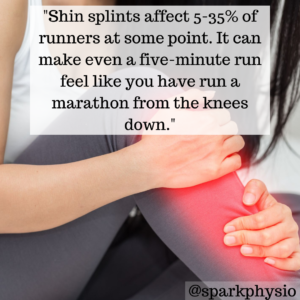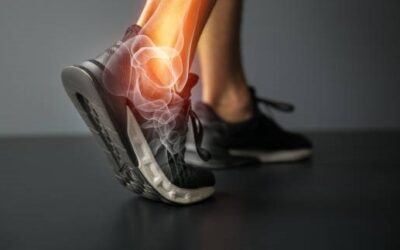
Shin splints (also known as medial tibial stress syndrome) is a debilitating injury that affects 5-35% of runners at some point. It can make even a five-minute run feel like you have run a marathon from the knees down.
We typically see patients who develop this condition after a sudden increase in their running mileage. These runners feel pressure to beat their last race time.
Or, our patients with shin splints are the new runners. These people are usually trying to go from couch to marathon and it is likely their legs haven’t built up the strength to handle the continuous load of running.
What Are Shin Splints?
It has long been considered that medial tibial stress syndrome was from the attachment of tibialis posterior and flexor digitorum longus muscles onto the tibia. But, ultrasound assessments of the lower legs of those complaining of lower leg symptoms and those with no symptoms revealed the same structural “abnormalities”. This means it is difficult to pinpoint the physiological source of the pain.
Risk Factors For Shin Splints
- Prior History of Shin Splints
- Hip Abduction Weakness:
- Research shows this as a probable link. So if there is any hip abduction weakness, it should be addressed.
- Increased Body Mass Index:
- Running causes the legs to accept a force 3-4x our body weight. It makes sense to decrease body weight to decrease the load on our legs.
- Decreased Ankle Strength
- The flexor digitorum longus has been proposed as a source of pain with those suffering from medial tibial stress syndrome. This muscle is weaker in those with a prior history of symptoms. But, the strength of the big toe is greater in those with a history of shin splints, likely reducing pain on the medial tibia.
- Poor Single Limb Stability
- If you have difficulty balancing and stabilizing on one leg (remember: running is a series of jumps), you may be putting more load on the medial tibia.
Prevention and Treatment
As with most injuries, a history of shin splints increases your risk of developing shin splints. The biggest factor in avoiding shin splints is to monitor your training/running volume. Do not rapidly increase your speed or mileage. Most guidelines being developed suggest not increasing your mileage more than 10% in a week.
Since shin splints occur due to an increase in load that your legs weren’t ready for, it is imperative to start strengthening and improve your lower body’s ability to tolerate load. How do you do that? Increase bone mass and muscle density in the lower leg. A good weight lifting program will take care of both of those as bone mass increases with loading, and we all know muscle gets bigger with loading. It is an extra benefit to focus on the calf muscles for runners as runners with larger calf muscles tend to have a lower incidence of shin splints.
Along with load management, another simple trick to treat yourself is to decrease your step length and increase your step rate. The combination of decreasing your step length and increasing your step rate reduces the load on the lower leg. This will reduce the likelihood of shin splints.
Not Helpful Technique
Most people are shocked to find out that research on the use of orthotics is inconclusive. In fact, some studies have shown that having a history of using orthotics increases your risk of developing shin splints.
Want help with getting rid of medial tibial stress syndrome? Apply here for a free consultation to discuss how Spark Performance and Physiotherapy can help you return to running…pain-free.




